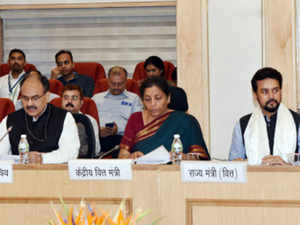NEW DELHI: Ahead of the crucial Goods and Services Tax (GST) Council meeting on September 20, the finance ministry has begun crunching the numbers to estimate the revenue it would lose in the event of rate reductions aimed at boosting demand during the festive season.
The fitment panel that examines rate changes is expected to meet shortly to consider suggestions mooted by some states as well as industry, two officials aware of the development told ET. The panel comprises central and state officials.
Among big-ticket consumer items, automobiles, tyres, cement, air conditioners and large LCD televisions are currently in the 28% bracket. Automobiles also bear a cess, depending on the size of the vehicle, further increasing the total tax incidence.
“Issues are being examined in detail… Numbers are also being looked at,” said one of the officials. Some states have already written to the Centre highlighting the need to cut rates on autos and cement to provide a boost to the economy. Some state policymakers are of the view that a more radical view of the rate structure needs to be taken, for instance merging the 12% and 18% slabs into one.
The key issue before the council meeting in Goa will be a possible cut in the tax incidence on automobiles, though there are differences among states on this issue. Punjab has suggested a comprehensive look at the rate structure while reducing levies for sectors such as automobiles to help turn the economy around. But Kerala is opposed to any such move.
West Bengal has also sought steps for the auto sector, particularly hybrid and Bharat Stage VI vehicles. BS VI prescribes more stringent emission norms for vehicles.
The Centre is weighing all options, one of the persons quoted said.
After the Reserve Bank of India cut the policy rate by 35 basis points in August, market watchers say it’s now up to the government to take fiscal measures to boost the economy. A basis point is 0.01 percentage point.
India’s economy grew 5% in the June quarter, its slowest pace in six years. Private consumption expenditure slowed to 3.1%, an 18-quarter low, while manufacturing grew 0.6%. With consumption having helped prop up growth in the past few years amid sluggish private investment and exports, any revival plan hinges on Indians loosening their purse strings during the festive season, which is when the bulk of sales take place traditionally.
High-frequency indicators have pointed to the slowdown getting more entrenched. The country’s largest car maker Maruti SuzukiNSE 0.60 % said Wednesday that it will halt production for two days this month as inventory piles up.
On Sunday, most companies including Maruti Suzuki, Hyundai, Mahindra & Mahindra, Tata MotorsNSE 3.79 % and Honda reported a further drop in sales in August. While Maruti Suzuki reported a 33% decline, Tata Motors witnessed a 58% drop.
GST rate cuts do not necessarily lead to a reduction in collections as they spur demand as well, experts said.
“Given the economic slowdown, there is certainly a case for reduction in rates for a few sectors such as auto,” said Pratik Jain, national leader, indirect taxes, PwC. “This has been done in the past and worked more often than not. Of course, this has to be backed up with other economic stimulus (measures) as well.”
For sectors such as real estate and railways, where input tax credit is restricted, there is a case for reduction in rates on key inputs, he said.
Jain said the GST Council may also want to consider merging the 12% and 18% slabs into a single one of possibly 15% or 16%, which will also simplify the rate structure. “However, it will not be an easy decision for the council and a larger consensus needs to be built for any major rate change,” he said.
Published On : 05-09-2019
Source : Economic Times

